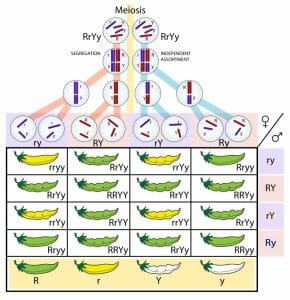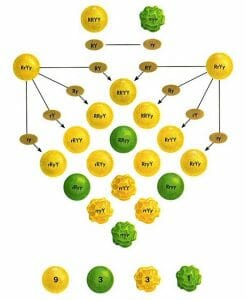Law of Independent Assortment Definition
The Law of Independent Assortment states that different genes and their alleles are inherited independently within sexually reproducing organisms. During meiosis, chromosomes are separated into multiple gametes. Genes linked on a chromosome can rearrange themselves through the process of crossing-over. Therefore, each gene is inherited independently.
Law of Independent Assortment Overview
This law describes the random inheritance of genes from maternal and paternal sources. According to the Law of Segregation, each chromosome is separated from its homolog, or counterpart, during meiosis. As such, the maternal and paternal chromosomes from your parents are “independently assorted”, meaning that chromosomes from the same source do not have to end up in the same gamete.
For instance, one gamete can end up with all maternal chromosomes, while another can have a mixture of both maternal and paternal chromosomes. This also means that the genes on these chromosomes are independently assorted. In effect, the Law of Independent Assortment creates a large amount of variety based on different combinations of genes which have not previously occurred.
In one instance, genes cannot be assorted completely randomly. This occurs with linked genes, or genes which share the same chromosome. However, the process of crossing-over during meiosis ensures that even these genes get rearranged. During crossing-over, homologous parts of maternal and paternal chromosomes can be exchanged. This ensures that even linked genes get independently assorted.
When Does Independent Assortment Occur?
Independent assortment occurs during the process of meiosis. Meiosis is similar to mitosis, only the final product is gamete cells. Gamete cells have half the DNA of regular, diploid cells and are considered haploid. This is a necessary part of sexual reproduction which allows two gamete cells to then fuse together to create a diploid zygote, containing all the DNA necessary to create a new organism.
To understand when independent assortment occurs, you must also understand the Law of Segregation. This law states that during meiosis, the two different copies of every gene are sorted into different gamete cells. The law of independent assortment, on the other hand, deals with the maternal and paternal sources of DNA being separated at random. To see these concepts in action, look at the image below:
As you can see, the law of independent assortment takes place as maternal and paternal sources of DNA are randomly divided. Sometimes, the gamete inherits the maternal version of a gene, and sometimes it inherits the paternal version. Which version it gets is completely random, based on the order that these chromosomes lined up in during the first stage of meiosis.
Law of Independent Assortment Examples
Independent Assortment in Meiosis
As a basic example, let us consider a hypothetical population of bunny rabbits that only have two visible traits: fur color (black or white), and eye color (green or red). The black fur allele (B) is dominant over the white (b), while the green eye allele (G) is dominant over red (g).
In this hypothetical example, two hybrid rabbits are mixed. What this means is that both rabbits look black with green eyes, but are really they have a heterozygous genotype. Both rabbits have the genotype BbGg. In this population of 2 rabbits, all the individuals have the same mixture of characteristics. In other words, they are all black with green eyes.
Before breeding, each rabbit will have to produce gametes. During this process, not only are the alleles separated (law of segregation), but each copy of each chromosome is randomly assigned to a different gamete. This means regardless of the parental phenotype (black with green eyes), the babies can inherit different combinations of these traits. For instance, one baby could receive the bbgg genotype, giving it white fur and red eyes. Alternatively, a baby rabbit could also receive the genotype Bbgg, giving it black fur and red eyes. This is the law of independent assortment.
Independent Assortment in Mendel’s Experiments
Gregor Mendel performed many experiments involving breeding pea plants. In doing so, he gleaned information about how “units of heredity” work, which would later on become known as genes after DNA was discovered and determined to be the material that encodes genetic information.
Mendel developed the Law of Independent Assortment after breeding two different pea plants with two different characteristics; he bred plants with yellow, round peas with plants that had wrinkled, green peas. Since yellow and round were dominant over wrinkled and green, all the offspring had yellow, round peas.
But, when this first generation was crossbred with each other in a dihybrid cross, there was a lot of variation in the second generation. Peas were no longer either just yellow and round or green and wrinkled; some were green and round, while some were yellow and wrinkled. Furthermore, the offspring showed their characteristics in a ratio of 9:3:3:1. Nine were round and yellow, three were round and green, three were wrinkled and yellow, and one was wrinkled and green. This ratio stayed the same even when hundreds of dihybrids were crossed.
This occurred because each of the parent plants only gave their offspring one allele and because yellow and round were dominant traits and masked the green and/or wrinkled traits in certain individual plants. The diagram below depicts Mendel’s dihybrid cross.
Mendel’s experiment showed that the alleles for round or wrinkled peas were inherited independently from the alleles for yellow or green peas since the plants were not just round and yellow or green and wrinkled. We now know that they exist on different chromosomes, which allows them to be mixed up during the process of meiosis.
Quiz


